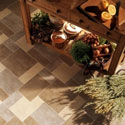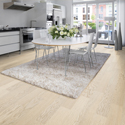| Start | Ideas | Articles | Books | Brands | Tools | Forum | Q & A | Local | Help | |||||||||||||||
|
|
| ||||||||||
Choosing the Perfect Flooring for a Kitchen
Introduction
When it comes to designing or renovating a kitchen, choosing the right flooring can make all the difference. The kitchen is not only a functional workspace but also the heart of the home, where family and friends gather to cook, eat, and socialize. Given its dual role, the flooring must enhance both the practicality and the aesthetic of the space. Selecting a kitchen floor that complements the design style, stands up to daily wear, and meets the specific needs of homeowners can transform this room into a stylish, functional hub. In this blog, we’ll explore various flooring options and how each fits into the unique needs of homeowners, consumers, and shoppers.
1. Room Purpose
The kitchen serves as both a functional workspace and a central gathering area. Flooring must withstand daily activities, from cooking and cleaning to hosting friends and family. A durable material like tile or luxury vinyl can be ideal for kitchens, as it combines longevity with an easy-to-clean surface. These materials are not only resilient but also water-resistant, essential for a high-traffic area that sees frequent spills. For homeowners wanting a cozier look, engineered hardwood is also a viable option, as it provides the warmth of wood with added durability suitable for busy kitchens.
2. Design Style
The flooring should harmonize with the kitchen's design theme, whether modern, farmhouse, or industrial. Hardwood and engineered wood flooring bring a warm, natural feel, ideal for farmhouse or traditional styles, while tile or vinyl in bold patterns can lend a modern, trendy touch. The flooring choice should consider the broader color palette and decor elements, including cabinetry, countertops, and lighting. For example, sleek gray tile might pair perfectly with a modern, minimalist kitchen, while rustic wood complements a cozy, farmhouse-inspired space.
3. Durability
In a high-traffic area like the kitchen, durability is crucial. Porcelain tile is one of the most durable options; it’s resistant to scratches, moisture, and heavy impact, making it ideal for families or busy cooks. Luxury vinyl is also a highly durable option, mimicking wood or stone while being resilient against spills and scuffs. Homeowners looking for long-lasting options will benefit from materials like tile or vinyl, which maintain their appearance even after years of daily use.
4. Moisture Exposure
Kitchens are exposed to moisture from cooking, cleaning, and spills, making water resistance a vital consideration. Tile and vinyl are both water-resistant and low-maintenance, allowing homeowners to clean up spills with ease. Hardwood, while beautiful, requires extra care in a kitchen setting due to its susceptibility to water damage. Engineered wood is a middle ground, providing a wood look with better water resistance, but vinyl remains the best choice for homeowners concerned about frequent exposure to moisture.
5. Budget
Flooring costs can vary significantly, so it’s essential to select an option that aligns with the renovation budget. Vinyl offers a budget-friendly solution with a broad range of styles that mimic pricier materials like wood or stone. Tile can range from affordable to premium, depending on the type and style. For homeowners on a tight budget, laminate and vinyl flooring are great choices, providing both aesthetics and functionality without breaking the bank.
6. Subfloor Condition
The condition of the subfloor influences the type of flooring that can be installed. Vinyl and laminate are often chosen because they can be installed over existing floors, reducing the need for extensive subfloor preparation. Tile, however, requires a stable and level subfloor. Evaluating the current condition of the kitchen subfloor can help homeowners choose a flooring material that minimizes installation time and costs.
7. Eco-Friendliness
For eco-conscious homeowners, sustainable options like bamboo flooring or eco-friendly vinyl made from recycled materials are ideal. Cork flooring is another sustainable option, offering both comfort and warmth while being a renewable resource. Homeowners can enhance their kitchen’s environmental footprint by selecting these materials, supporting both sustainability and style in their design.
8. Soundproofing/Insulation
Kitchen flooring should balance practicality with comfort, as the kitchen is a social space. Some materials like cork or luxury vinyl have sound-dampening properties, making them ideal for open-concept layouts where kitchen noise can carry. Hardwood with an insulating underlayment can also help dampen sound, providing a quieter environment that makes the kitchen a comfortable gathering spot for family and friends.
9. Health Considerations
Health-conscious homeowners may prioritize materials that do not off-gas or emit VOCs (volatile organic compounds), which can affect indoor air quality. Natural materials like wood and cork, or certified low-VOC vinyl options, are ideal choices for reducing exposure to chemicals. This is particularly important for families, as these materials promote a healthier indoor environment, ensuring the kitchen remains a safe and welcoming space for everyone.
Key Factors in Flooring Selection
Color Scheme and Visual Appeal
The color and style of kitchen flooring can influence the room’s visual appeal. Light-colored tile or vinyl can make a small kitchen appear larger, while darker tones lend an intimate feel. The choice of flooring should align with the overall color scheme to create a harmonious space.
Style and Theme Coherence
Flooring plays a crucial role in theme cohesion. For a contemporary look, sleek tiles work well, whereas natural wood adds a warm, rustic vibe to farmhouse kitchens. Flooring should complement other design elements to maintain a consistent style.
Texture and Feel
Texture affects both the look and feel of the kitchen. Textured tile or matte-finished vinyl provides grip and prevents slipping, enhancing both safety and comfort. The tactile quality of flooring contributes to the kitchen’s inviting atmosphere.
Room Size Perception
Larger tiles or continuous patterns can make a compact kitchen feel more spacious, while smaller tiles or dark-colored flooring can make large kitchens feel cozier.
Comfort and Usability
Materials like vinyl and cork offer a cushioned surface, which is beneficial for prolonged standing while cooking. These options prioritize both style and comfort, making them ideal for busy kitchens.
Acoustic Impact
Materials with sound-dampening qualities, such as cork or underlayment-equipped vinyl, can reduce echo and noise in open-concept kitchens, creating a quieter, more relaxed ambiance.
Pattern and Focal Points
Patterned flooring adds visual interest and can serve as a design focal point, while neutral options allow other elements, like cabinetry or backsplashes, to stand out. This balance between simplicity and statement pieces creates a cohesive design.
Conclusion
Choosing the right kitchen flooring can transform the space, blending functionality with style to create a room that truly feels like the heart of the home. Considering factors such as durability, moisture resistance, and aesthetics ensures that the selected flooring will stand up to the demands of daily life while enhancing the kitchen’s visual appeal. From vinyl and tile to engineered wood and sustainable options, each material offers unique benefits, allowing homeowners to select a flooring option that aligns with their design vision, lifestyle, and budget. With the right choice, your kitchen can become a stylish, durable, and inviting space that meets all your functional needs.
These brands are a great starting point: Shaw Tile Flooring Mannington Resilient Vinyl Flooring
![]() Room Ideas
Room Ideas
Not sure where to begin? Our Room Ideas Section is organized by rooms. Simply select the room you want to decorate and browse through hundreds of room scenes.
![]() News
News
Want to see what's new? Our News Section will brings you up to date information on brands, products, promotions and events.
![]() Books
Books
Our Books Section provides you in-depth customer reviews about books that contain information about . Find out what books are hot and what books are new.
![]() Brand Info
Brand Info
Use our Brands Section to browse different brands of . Click here to find the brand you want or be introduced to a new one.
![]() Design Tools
Design Tools![]()
Use a manufacturer's design tools to create a customized room scene using the products and styles offered by that manufacturer.
![]() F.A.Q's
F.A.Q's
Our F.A.Q.'s are answered by design and home improvement professionals. It features problems and solutions to various remodeling dilemmas.
![]() Local Directory
Local Directory
Looking for local retailer or installer of . Use our handy zip code locator or browse our directory by state and city.








